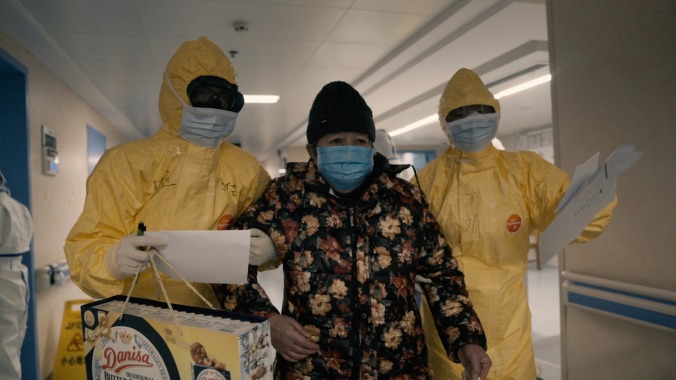The gripping 76 Days chronicles the chaotic start of the COVID-19 outbreak

One of the three people who directed 76 Days, a documentary portrait of the COVID-19 crisis in Wuhan, is credited only as Anonymous, perhaps due to some legally problematic association with the hospital where most of the film was shot. That seems apropos in another way, though: Virtually everyone who appears on screen is functionally anonymous. All of the doctors and nurses working tirelessly to save lives are decked out in protective equipment that’s just one notch down from a hazmat suit; the film occasionally names them via superimposed text, but it’s still nearly impossible to keep track of who’s who. The patients, similarly, have their faces largely obscured, either by standard face masks or (much too frequently) by oxygen masks and intubation tubes. The visual interchangeability serves as a reminder that this exact same nightmare has played out all over the globe this year. Wuhan just happened to go through the wringer first, totally locking down a city more populous (11 million) than any in America.
That happened on January 23, nearly two months before U.S. cities began to follow suit. 76 Days—which, as its title suggests, chronicles events through April 8, when the lockdown was lifted—opens at maximum chaos, as a crowd of potentially infected and plainly terrified people hammer the doors of a hospital that’s already short on available beds. Like the rest of the film, this scene is shot vérité-style, without any context (apart from the aforementioned dates, noted at the beginning and end) or direct-to-camera interviews. The film often resembles nothing so much as a Chinese version of ER (special pandemic episode), complete with that show’s abrupt shifts from antic to frantic and back again. The medical staff struggles to keep their spirits up amidst all the grief, drawing cartoon figures on each other’s bright white gowns and making the patients “get well soon” balloons out of inflated surgical gloves. Identifiable “characters” do eventually emerge, including a young couple whose newborn daughter has to go straight into quarantine and an elderly man suffering from dementia who keeps trying to wander outside in the middle of the night.
Still, the overall impression 76 Days delivers is that of dedicated professionals coping with an unprecedented onslaught of emergencies to the best of their ability, grimly waiting for the curve to flatten. As days stretch into weeks, certain patients visibly deteriorate; the film affords them the dignity they deserve, but an overflowing container bluntly labeled “ID cards and phones of the dead” speaks sorrowful volumes. Through all of this, it’s sobering to remember that we’re seeing footage shot primarily during a time when the average American was still only dimly aware of COVID-19. By the time Tom Hanks announced that he’d tested positive, and the NBA postponed the rest of its season, Wuhan was nearly out of the woods—and it’s since stayed out, avoiding the resurgence that other countries (most notably the U.S.) have experienced. 76 Days’ exposition-free, you-are-there approach doesn’t allow for any criticism of how China handled the initial outbreak, nor can it address the question of whether cases and deaths were deliberately undercounted. But it does have a happy ending of sorts that’s yet to arrive here.